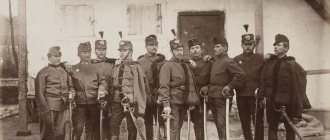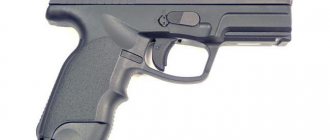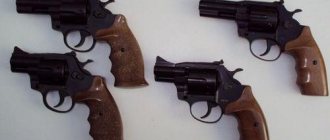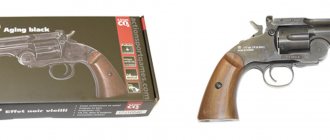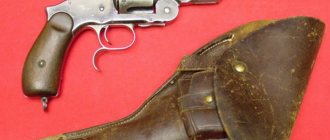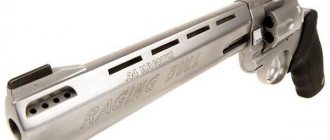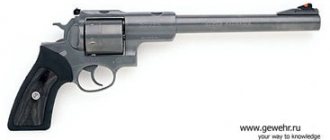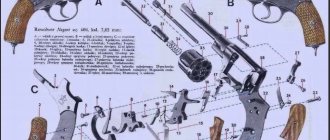Revolver from the world of steampunk
One of the most beautiful revolvers in general and models of the late 19th century in particular. He is simply magnificent in his aesthetics, uniqueness, elegance and sophistication of design, but most of all in his charisma. And yet, if we go beyond the strictly weapons-historical framework, the “Montenegrin” Gasser, in my opinion, is an excellent example of a steampack weapon, on a par with the Gatling machine gun, the first self-loading pistols, such as Mauser and Borchardt, self-loading rifles, and also the first rifled guns .
The Gasser M1870/74 "Montenegro" was designed on the basis of the M1870 army revolver and differs from earlier models designed by Leopold Gasser in that it has an extractor that retracts inside the cylinder axis. This design of the extractor made it more convenient to carry a revolver in the belt, as was customary in Montenegro.
The revolver has an open frame. The barrel boss is screwed onto the fixed axis of the drum and fixed with a screw that connects the boss to the frame. The drum was loaded through a hinged door located on the right side.
The trigger mechanism is hammer-type, double-action, having a device for setting the hammer to safety cock. On the right side of the frame, under the drum, there is a safety lever that interacts with the trigger mechanism.
To put the trigger on the safety cock, you need to pull it back a little, after which you can safely carry a loaded revolver with cartridges in the chambers of the drum. To fire, it was enough to simply squeeze the trigger.
Encyclopedia of weapons
Rast-Gasser M1898
Tactical and technical characteristics of Rast-Gasser M1898: Caliber, mm — 8 mm Rast & Gasser (8.1x27mm, 8.2×27.5mm) Length, mm — 225 Barrel length, mm — 116 Weight without cartridges, g — 980 Rifling — 4 Drum capacity — 8 Initial bullet speed, m/s — 240
The company, founded by Leopold Gasser in the 1860s, armed not only the army of the Austro-Hungarian Empire, but also a significant part of the Balkans with revolvers of various designs of its own design. The production of these revolvers reached hundreds of thousands of units per year.
The last model on which the name Gasser appears was the model of the service revolver Rast-Gasser M1898 (Rast-Gasser model 1898), adopted by the Austro-Hungarian army.
The Rast-Gasser M1898 revolver was developed by the designer of the Gasser company, August Rast, taking into account the shortcomings identified during the operation of previous systems.
The Rast-Gasser M1898 revolver has a solid frame, the main difference of which is the almost complete absence of threaded connections. The smooth, fluted drum has eight chambers for 8 mm Rast & Gasser cartridges.
Extraction of spent cartridges is carried out sequentially using a spring-loaded extractor located on the right under the barrel after opening the Abadi door located on the right side of the frame. The extractor lever in the firing position is fixed with a latch on the drum axis. When unloading, it rotates 90 degrees relative to the extractor axis and serves as a stop.
A design feature of the trigger mechanism is that when the door is turned back down, a profile cam located on its axis disconnects the trigger from the hammer. This allows the drum to be rotated when loading or unloading with a relatively light pull on the trigger.
Due to the exact coincidence of the drum socket with the extractor rod each time the trigger is pressed, the process of reloading the weapon is accelerated and its combat rate of fire increases. For this characteristic, the Rast-Gasser M1898 revolver was the best among alternate extraction systems.
The trigger mechanism is hammer-type with an open, rebound trigger, double action. Allows you to fire both self-cocking and with pre-cocking. Unlike many revolvers of the 19th century, the 1898 model has a firing pin located not on the trigger, but in a special socket on the frame, thereby eliminating misfires due to the fault of the weapon.
Moreover, the trigger is disconnected from the spring-loaded striker and can only act on it when the trigger is fully pressed. This so-called “safety” platoon achieves a high degree of weapon safety.
Open-type sights consist of a front sight on the barrel and a slot on the upper wall of the frame.
The angle between the handle and the bore is straight, in accordance with the traditions of the time. The handle is equipped with a ring for a strap and wooden cheeks with a notch.
The entire design of the revolver is characterized by simplicity, reliability and ease of use. The process of disassembling it has been simplified to the limit, carried out without the use of any tools. To access the trigger mechanism, simply press the base of the trigger guard, on which the latch is located, turning it relative to its axis. After this, you can easily lift up the left half of the frame near the handle.
The Rast-Gasser revolver, due to its simplicity of design, convenience and operation, and the high ballistic characteristics of the 8-mm cartridge, along with Steyr automatic pistols, remained in service with the Austro-Hungarian army until the end of the First World War.
Then, after the defeat, along with most of the Austrian small arms, these revolvers were taken as trophies to Italy, where they were widely used until the end of the Second World War. And after the end of the war, they were popular in Italy, since, perhaps, the only company in the world that produced 8-mm cartridges for this revolver remained Giulio Fiocci in Lecco (GFL).
‹ Gasser-Kropatschek M1876 Up Glock GmbH ›Rast Gasser M1898
Catalog/MMG pistols/Rast Gasser M1898
The company, founded in the 60s of the 19th century by Leopold Gasser, armed not only the army of the Austro-Hungarian Empire, but also a significant part of the Balkans with revolvers of various models of its own design. Their production reached hundreds of thousands of pieces per year. And although the founder of the company died in 1871, successors in subsequent models made extensive use of his patents. The latest model of a revolver, adopted by the Austro-Hungarian army at the very end of the 19th century under the name “Rast-Gasser Model 1898,” was no exception. Taking into account the shortcomings identified during the operation of previous systems, it was developed by the designer of the Waffen Factory Leopold Gasser, August Rast.
The revolver has a solid frame, the main difference of which is the almost complete absence of threaded connections. The angle between the handle and the bore is straight, in accordance with the traditions of the time. The whole thing is a slot in the frame, the front sight is located in the tide on the barrel and can be adjusted in the horizontal plane. The double-action trigger mechanism allows firing both by self-cocking and with pre-cocking of the hammer. Unlike many revolvers of the 19th century, the 1898 model has a firing pin located not on the trigger, but in a special socket on the frame, thereby eliminating misfires due to the fault of the weapon. Moreover, the trigger is disconnected from the spring-loaded striker and can only act on it when the trigger is fully pressed. This so-called “safety” platoon achieves a high degree of weapon safety.
The smooth, fullless drum has eight slots. Extraction of spent cartridges is carried out sequentially using a spring-loaded extractor located on the right under the barrel after opening the Abadi door located on the right side of the frame. The extractor lever in the firing position is fixed with a latch on the drum axis. When unloading, it rotates 90 degrees relative to the extractor axis and serves as a stop. A design feature of the trigger mechanism is that when the door is turned back down, a profile cam located on its axis disconnects the trigger from the hammer. This allows the drum to be rotated when loading or unloading with a relatively light pull on the trigger. Due to the exact coincidence of the drum socket with the extractor rod each time the trigger is pressed, the process of reloading the weapon is accelerated and its combat rate of fire increases. According to this characteristic, the Rast-Gasser revolver was and remains the best among systems with alternate extraction.
The process of disassembling the revolver has been simplified to the limit, carried out without the use of any tools. To access the trigger mechanism, simply press the base of the trigger guard, on which the latch is located, turning it relative to its axis. After this, you can easily lift up the left half of the frame near the handle.
The Rast-Gasser revolver, due to its simplicity of design, convenience and operation, and the high ballistic characteristics of the powerful 8-mm cartridge, along with the Steyer M1912 automatic pistols, remained in service with the Austro-Hungarian army until the end of the First World War. Then, after the defeat, along with most of the Austrian small arms, these revolvers were taken as trophies to Italy, where they were widely used until the end of the Second World War. Apparently, they are still popular in Italy today, since, perhaps, the only company in the world that produces 8-mm cartridges for this revolver remains Giulio Fiocci in Lecco (GFL).
| Performance characteristics of the Rast-Gasser revolver | |
| Caliber, mm. | 8 |
| Massa, city | 850 |
| Length, mm. | 225 |
| Barrel length, mm. | 114 |
| Magazine capacity, cartridges | 8 |
The last model on which the name Gasser was the 1898 model of the Rast and Gasser service revolver, adopted by the Austro-Hungarian army.
This eight-round weapon with a solid frame had an ejector ramrod under the barrel. The loading door, connected to the Abadi mechanism, was located on the right side of the frame and, when opened, disconnected the hammer and trigger.
The rectangular handle of the Rast and Gasser revolver was almost perpendicular to the bore, which made it very difficult to shoot offhand, without aiming, but the weapon itself was of high quality and reliability.
It has a one-piece frame with a round barrel screwed to it. The drum, which holds 8 rounds, is quite simple, except for the slotted holes to secure it. The revolver is loaded through the rear door, on which there is a small protrusion that ensures the alignment of the drum and frame. When the charging door is open, the hammer does not operate, but the drum can be rotated by the trigger, which speeds up the loading process. A regular cutout is made on the frame so that the cartridges can easily fall into the drum. The extractor rod is hollow, located on an axis that is connected to the barrel boss. Double action trigger mechanism. Access to the mechanism is possible when the hinged cover is open and covers almost the entire left side of the frame. The revolver looks old-fashioned; It was more convenient to shoot from it with a half-bent arm. Although the weapon was made with high quality, it was of little use for military operations, since the power of the cartridges used was low.
$1100
0084
